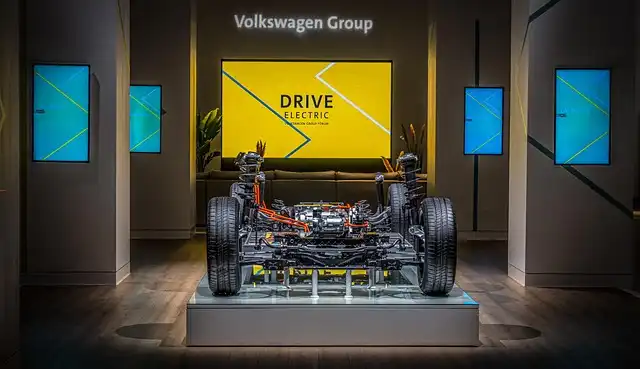EV Tax Credit Ends: Impact on Consumers & Industry

The EV tax credit's expiration impacts consumers and the EV industry. Ford CEO anticipates a significant sales decrease. Tesla adjusts lease pricing. Hybrid vehicles gain traction. Future of EV market is uncertain.
Invite back to Essential Products, your one-stop shop for the greatest information in the EV world. Today, we’re concentrating on early responses to the EV tax obligation credit rating’s influence, and what it will certainly imply for consumers since it’s dead. Allow’s hop right in, folks.
End of EV Tax Credit Impact
It’s no secret that the EV tax obligation credit was a boon to the industry. That $7,500 credit history helped a lot of buyers afford EVs, whether it was using an acquisition reward done right at the point of sale or positioned into a lease. We’re currently beginning to understand the fallout of what this will certainly indicate for the EV industry as a whole. And the chief of one huge American automaker states it’s already detering his strategies.
Guy, EV firms can’t catch a break, huh? For a very long time, the united state EV market was greatly reliant on Tesla for a lot of factors; the automobiles themselves were type of the only video game around that deserved a damn to the average consumer.
Tesla’s Market Dominance & Challenges
Array, rate and basic usability struck all of the wonderful spots with customers, especially with the (relatively) fairly priced Model 3 and Version Y. Add in the tax credit report, and points were good for Tesla.
It’s the first of October, which implies the electric-vehicle tax debt is formally dead, having died in the wee hours of the morning. Speaking of “morning”, we, and more than a few car firms, are grieving its fatality.
And since various other car manufacturers are finally starting to catch up, they’ve been removed at the knees. The tax obligation debt was a large reward for American cars and truck buyers, and currently it’s gone. According to reporting from Fortune, Ford chief executive officer Jim Farley said that the death of the EV tax obligation credit rating can cut the industry in half:
Ford’s Perspective on EV Sales
While he still sees EVs being a “lively sector” moving forward, it’s likewise “going to be smaller, way smaller than we assumed.” He called the end of the $7,500 consumer reward a game-changer and stated he wouldn’t be surprised if EV sales in the U.S. decrease to 5% of the market from the current degree of about 10% to 12%. One of the most recent projection from J.D. Power and GlobalData estimated that EVs would certainly account for 12.2% of new-vehicle sales in September 2025.
Farley reminded the target market that he constantly states, “The clients are pesky. They stun you.” And what he’s found out is that “customers are not thinking about a $75,000 electrical vehicle. They locate them intriguing. They’re quick. They’re effective. You don’t most likely to the gas station. They’re expensive.”
Hybrids Gain Popularity
“Partial electrification is more fascinating to customers than we thought … we believe crossbreed, EV plug-in, E-revs, those type of partial electrical remedies, America is going to fall for, or currently is falling in love with.” And they’re befalling of love with pure-play EVs, he suggested.
This feels like a full no-brainer. Until relatively lately, EV efforts from many companies that aren’t Tesla have been aimed at the upper-class purchaser. And a $75,000 cars and truck, no matter if it’s electrical or otherwise, is a high-pressure salesmanship in today’s globe, where customers feel incredibly pressed by an increased price of living.
The end of the tax credit isn’t terrific information for the EV market, and also the supply chain that has actually been building up to support what everybody thought would certainly be a boom time in American car manufacturing. The globe will certainly continue to go electrical, so let’s wish this is short-lived.
While automakers and regional dealers are clambering to upgrade their rewards and sales pricing, there’s no slacking at Tesla. Detected by Reutersand validated by us, Tesla has currently altered its lease pricing on its brand-new EV versions:
Tesla Adjusts Lease Pricing
And yet the world remains to amaze. I’m not going to insist that the tax obligation credit score did nothing. In a globe where individuals shop for autos mainly based on their regular monthly repayments, did those offers assist as much as, claim, a more affordable EV in general?
The federal motivations to both buy and build zero-emission vehicles are primarily chosen now, however the U.S. hasn’t rather reached rate parity en masse for EVs and combustion cars. It seems like we were getting close, but the little bit of assistance to get us over the line is now completely gone.
These prices do not feel like way too much of a stretch. A dive from $349 to $429 for the Tesla Design 3 isn’t trivial, specifically for customers on a budget, but this still really feels competitive with similarly priced costs internal-combustion sedans.
The month-to-month lease of the electrical vehicle manufacturer’s very successful Design Y increased to a range between $529 and $599, from a range of $479 to $529. Rates of all lorries, nevertheless, continue to be unmodified. Version 3 lease prices touched a series of $429 to $759 each month, from a series of $349 to $699.
Various other models quoted, like the Version 3, Hyundai Ioniq 5, and Ford Mustang Mach-E, floated around a 60%-ish lease price. And in some ways this makes sense: The Model Y, for example, qualified for a debt when bought, while the Mach-E really did not.
The EV tax obligation credit rating truly helped with leasing in particular. Not long ago, before the credit history passed away completely, new legislation reconfigured the plan so it would only apply to new purchases of autos made in North America.
Leasing loophole
Those restrictions really did not use to cars had by industrial entities, producing a brilliant technicality for leases. Leasing business can claim the credit history and pass it on to lessees, lowering the first cost and monthly payment. Therefore, you ‘d assume that many, if not all, EV purchases would certainly be rented?
The Tesla Design Y was the top-selling electrical lorry in the 2nd quarter of 2025 but only 30 percent of those sales were for leases, according to Experian. Concerning fifty percent of all Design Y consumers financed their purchase with a loan.
It’s no key that the EV tax credit history was an advantage to the sector. That $7,500 credit assisted a great deal of customers afford EVs, whether it was via a purchase incentive done right at the point of sale or positioned into a lease. Today, we’re concentrating on early reactions to the EV tax obligation debt’s effect, and what it will certainly mean for customers now that it’s dead. According to reporting from Ton of money, Ford Chief executive officer Jim Farley stated that the fatality of the EV tax debt could cut the sector in fifty percent:
He called the end of the $7,500 customer incentive a game-changer and claimed he would not be stunned if EV sales in the United state go down to 5% of the market from the current level of roughly 10% to 12%.
1 affecting Ford Broncos2 electric vehicles back
3 EV market
4 EV tax credit
5 feature Tesla
6 lease pricing
« Hyundai’s Sales Surge: Best September & Future PlansGM: Cadillac Leads Luxury EV Sales + Future EV Plans »
